Elisenlebkuchen (Elizabeth’s Lebkuchen)
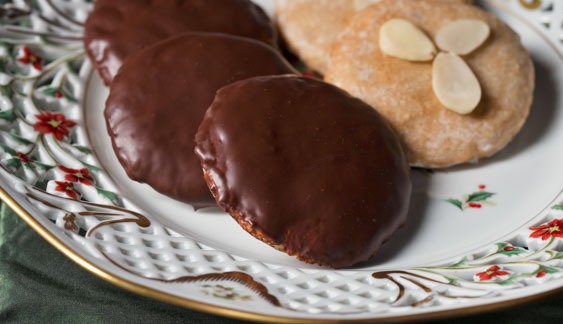
introduction
In the 12th century, Nuremberg was a well-populated imperial city in the center of Europe, which found itself, correspondingly, at the center of the European spice trade. The city imposed tolls on the Spice Road traders, which were frequently remitted in the form of spices themselves. It was a meaningful happenstance for a city whose surrounding countryside was home to more bees and beekeepers than elsewhere in the region. Local bakers used the convergence of two rare and expensive commodities to devise a special cookie, Lebkuchen. We call it gingerbread. Lebkuchen became so important in Nuremberg around this time that bakers who apprenticed to learn the craft formed a gingerbread guild. Now a city in Middle Franconia, Bavaria, Nuremberg remains at the very least the honorary seat of Lebkuchen culture and production in Germany today.
Modern manifestations of Lebkuchen are several, but they can be gathered into two broad categories: one is a kneaded cookie dough containing a good proportion of flour, as well as honey and spice, that is rolled out and stamped into shapes (like our gingerbread cookies). Often called Braune Lebkuchen, Pfeffernüsse (pepper nuts), and Aachener Printen (gingerbread rectangles from the city of Aachen) fall into this category. The other, and most refined, Lebkuchen is a nut meringue of sorts, stippled with candied fruit, and so delicate it must be baked on thin wheat baking wafers called Oblaten. (It can be no accident that Oblaten bear a striking resemblance to communion wafers—Lebkuchen emerged from the monasteries and cloisters that gave it heartbeat in the 11th century.)
Historical accounts suggest that the word Lebkuchen derives from “life” (Leben) or “body” (Leib), possibly because its potent spice mix was thought to heal or strengthen the body. In fact, the nine-spice collection (called Neunerlei Gewürze) associated with the flavor of Lebkuchen could, if used all together, possibly cure anything. In fact, the namesake of these delicacies, Elizabeth, is said to have been the beloved only daughter of a widowed Lebkuchen baker. When Elizabeth suddenly became gravely ill and doctors were unable to cure her, her father used his understanding of the healing properties of Oriental spices to create a unique Lebkuchen just for her. He struck flour from the traditional recipe and loaded it instead with high-quality nuts, fruits, and egg whites. Elizabeth recovered. Today, Elisenlebkuchen may contain no more than 10 percent flour by weight.
We think that Elisenlebkuchen, which are actually more like small, moist cakes, have the most mysteriously enticing flavor and allure of all German Christmas cookies. Ground hazelnuts and almonds, chopped candied orange peel and citron, marzipan, dark rum, and a measured but potent mix of Lebkuchen spices, folded into a billowy meringue and baked on Oblaten, are beautiful and riveting on their own. But dip them in melted couverture or brush them with a thin sugar glaze, and they become kind of over-the-top fabulous. As you glance down this page, you may well regard it is the weirdest cookie recipe you’ve ever seen. And we’ll grant you that this is no Hershey’s-kiss-pushed-into-a-peanut-butter-cookie degree of difficulty. But we worked hard to make the recipe as approachable as possible. In the end, when you look at your Elisenlebkuchen, you won’t believe you actually made these exotic beauties. Taste one and you will realize they are so worth it.
Baking Notes
Lebkuchen is all about spices. Do yourself and this recipe a favor and buy some new ones! We like the Spice House.
The flavor of ground hazelnuts contributes significantly to the magic that is Elisenlebkuchen. But those who love hazelnuts also know they are a nuisance to peel. Yet we urge you not to purchase whole blanched hazelnuts. The more any nutmeat is processed, the more quickly its oils grow rancid. Blanched hazelnuts age out faster than some other nuts, in our opinion. Or maybe it is simply that hazelnuts make fewer appearances in American baking than almonds, and the ones in grocery stores are thus likely to be old and stale. But SunOrganic Farm in California sells exquisitely fresh whole hazelnuts—and we provide easy directions for blanching them.
You will discover Kühle Back Oblaten to be the singular brand of these thin baking wafers available for purchase in the United States. Yet they can be fresh or they can be stale. Some we purchased from Amazon stuck together and had to be pried apart with the tip of a small sharp knife. We don’t know who that particular vendor was, but we’re thinking German Deli is probably a safer choice.
It can be a real test of patience to find good candied fruit in the U.S. Who really wants to bake with the jumbled-up mixed fruits stained with dyed cherries? The best you’re going to do is www.nuts.com’s candied citron and glazed orange peel, which comes in strips and isn’t sticky or gooey.
Comporting with their age and tradition, many German Christmas cookies—in particular, the dark brooding varieties like Lebkuchen—use an ancient form of leavening called Hirschhornsalz that predates baking soda and powder. In the United States, it is known as baker’s ammonia (short for ammonium carbonate). It smells ghastly, exactly like the smelling salts used to revive Victorian women who succumbed to the fainting couch. But it does good things in baked goods. Because baker’s ammonia is not activated by liquid, but by heat, doughs made with it may be left to languish and ripen in the refrigerator without suffering any loss of oven bounce. Baker’s ammonia reacts quickly and creates an even oven spread, particularly in low-moisture cookies. Cookies bake up crisp, with an open crumb, and stay crisp for long periods, making baker’s ammonia the ideal leavening for the sorts of German Christmas cookies meant to be stored for the season. The particular chemistry of baker’s ammonia also affects the flavor of cookies that are heavy with spice, rendering them, in our opinion, more authentic. Its odor dissipates at temperatures above 140 degrees. King Arthur Flour sells baker’s ammonia, as do other online vendors.
And finally, the chocolate, if that is your glaze of choice. You don’t have to use any, mind you—Lebkuchen with sugar glaze are delightful, too, and much easier to make. But a crisp chocolate glaze really offers an exciting dimensionality to these cookies. And what can we tell you, guys, is that we love Valrhona. We love their baking lozenges (fèves) and any of their bittersweet chocolates in the 60 to 70 percent range (the percentage refers to the amount of chocolate liquor in any given formula), with our top prize going to Valrhona Illanka baking fèves, which is also Rose Levy Beranbaum’s new favorite baking chocolate. Raw cocoa butter increases the fat in the dipping chocolate, making it a bit thinner and easier to use as a glaze. Caution: this stuff is frequently rancid. But we found nice, raw, food-grade cocoa butter produced in the Caribbean on Amazon.
equipment mise en place
For the cookies, you will need a digital kitchen scale, two heavy baking sheets, silicone baking mats or parchment paper, a heavy-bottomed large saucepan, a medium bowl, a small bowl, a stand mixer fitted with the whisk attachment, a rubber spatula, a small icing spatula, a 2-inch ramekin or small drinking glass, a shallow container, a small icing spatula, and two wire racks.
For the sugar glaze, you will need a digital kitchen scale, a small bowl, and a whisk.
For the chocolate glaze, you will need a digital kitchen scale; a medium saucepan; a clean, dry heatproof bowl that sits snugly on top of the saucepan; and a digital instant-read thermometer.
-
for the cookies:
-
6.5ounces hazelnuts
-
1ounce baking soda
-
4ounces blanched whole almonds
-
4.6ounces almond paste, pulled or sliced into pieces
-
1ounce diced candied orange peel (see Baking Notes)
-
1ounce diced candied citron
-
1.4
-
½teaspoon ground cinnamon
-
½teaspoon ground cardamom
-
½teaspoon ground anise
-
⅛teaspoon ground cloves
-
⅜teaspoon fine sea salt
-
1tablespoon dark rum
-
1teaspoon baker’s ammonia
-
4ounces egg whites
-
5ounces superfine sugar
-
1box 70-mm Back Oblaten (baking wafers)
-
-
for the sugar glaze:
-
3ounces confectioners’ sugar, sifted
-
1½teaspoons juice from 1 lemon
-
2teaspoons water
-
¼teaspoon vanilla extract
-
Sliced almonds, for garnish (optional)
-
-
for the chocolate glaze:
-
1pound high-quality bittersweet chocolate (60% to 70% cocoa solids), chopped
-
2tablespoons finely chopped or shaved cacao butter (optional)
-
-
Make the cookies: Adjust the oven rack to the middle position and heat the oven to 350 degrees. Line a baking sheet with a silicone mat or parchment paper.
-
Bring 1 quart of water to a boil in a heavy-bottomed large saucepan over high heat. Add the baking soda and the hazelnuts; expect the water to darken and boil energetically (fig. 2.1). Boil until a trial hazelnut rescued from the water with a fork and run under cold water releases its skin easily when rubbed between the fingers, 2 to 3 minutes. Drain the hazelnuts, rinse them under cold water (fig. 2.2), and rub off their skins. Dry the nuts on paper towels. Turn them onto the prepared baking sheet and roast until dry and very lightly browned, 10 to 12 minutes. Remove from the oven and let cool completely (fig. 2.3).
-
While the hazelnuts are cooling, turn the almonds into a food processor and process to a fine meal, about 30 seconds. Transfer them to a medium bowl. Turn the candied orange peel and citron into the food processor and pulse to tiny bits, about ten 2-second pulses (fig. 3.1). Add the minced candied citrus to the almond meal.
-
Turn the cooled hazelnuts into the food processor and process to a fine meal, about 30 seconds. Add the almond paste (fig. 4.1) and pulse until it is incorporated into the nuts, about ten 1-second pulses. Add this mixture to the almond and candied citrus mixture and stir to combine. Add the flour, cinnamon, cardamom, anise, cloves, and salt and rub the ingredients with your fingertips to fully incorporated (fig. 4.2). Set aside.
-
In a small bowl, stir together the baker’s ammonia and rum until the baker’s ammonia dissolves. (If it doesn’t fully dissolve, heat the mixture in a small saucepan over low heat, stirring constantly.) Set aside.
-
Pour the egg whites into a clean stand mixer bowl. Fit the mixer with a clean whisk attachment and beat the whites on medium speed until they hold soft peaks, about 1½ minutes. With the machine running, stream in the superfine sugar and continue beating until the egg whites are thick and glossy with slightly drooping tips (fig. 6.1), about 4 minutes more. Remove the bowl from the mixer and knock the meringue off the whisk attachment. Add the nut mixture to the meringue and fold with a rubber spatula (fig. 6.2) until combined. Add the rum mixture and fold to incorporate. The dough will be soft and sticky. Turn it into a shallow container, cover, and refrigerate overnight.
-
The next morning, line 2 baking sheets with parchment paper or silicone baking mats. Remove the dough from the refrigerator; it will have become firmer but will still be a bit sticky. Portion the dough into 1-ounce pieces. With clean, dry hands, arrange as many baking wafers as you have dough pieces on the baking sheets, spacing the wafers about ¾ inch apart. Roll each piece of dough between the palms of your hands into a ball. Place a dough ball solidly in the center of each wafer paper (fig. 7.1). Wash and dry your hands.
-
Press a small icing spatula very lightly onto a dough ball, lift up the dough with its wafer (fig. 8.1), and bring them closer to you on the countertop. Dip the bottom of a 2-inch ramekin or small drinking glass in water, shake off the excess, and, using a twisting motion, press the ball of dough into a smooth disk that covers all but the very outer edge of the wafer paper; take care not to wet the wafer (fig. 8.2). Smooth the surface of the dough with the spatula, slide the spatula off the dough to free it (instead of lifting it off), and return the cookie to the baking sheet. (Alternatively, moisten your fingers lightly with water and flatten the balls, and then use a small icing spatula dipped in water to smooth and spread the dough to just shy of the edges of the wafer.) Let the cookies stand at room temperature until the tops are dry to the touch, about 2 hours (fig. 8.3).
-
Adjust an oven rack to the lower-middle position and heat the oven to 325 degrees.
-
Bake the cookies one baking sheet at a time until the surfaces are no longer shiny and the edges are lightly brown, 12 to 14 minutes. Let cool on the baking sheet for 5 minutes, and then transfer the cookies to wire racks. Let cool completely.
-
Make and apply the sugar glaze: In a small bowl, whisk the confectioners’ sugar, lemon juice, water, and vanilla to form a thin, runny glaze. Holding a cookie over the bowl, spoon glaze onto the cookie’s surface (fig. 11.1), allowing the excess to drip back into the bowl. (Don’t glaze the bottom.) Return the cookie to the wire rack; you may arrange 3 sliced almonds on top for garnish (fig. 11.2). Let the glaze dry completely. Store the cookies in an airtight container between sheets of waxed or parchment paper. They will keep for up to 1 month.\n\n_Make and apply the chocolate glaze: _Heat 1 to 2 inches of water in a medium saucepan over medium-high heat. Meanwhile, weigh out 12 ounces of the chopped chocolate into a clean, dry heatproof bowl that sits snugly on top of the saucepan. Finely chop the remaining 4 ounces of chocolate and set it aside. When the water reaches a bare simmer, no hotter, remove the pan from the heat and set the bowl with the larger amount of chocolate on top; the water should not make any contact with bottom of the bowl. Melt the chocolate, stirring it regularly with a clean, dry spoon, until it registers 114 to 118 degrees on a digital instant-read thermometer. To protect the chocolate from overheating, it is best to remove the bowl from the saucepan before all of the chocolate has melted and to melt the remaining bits with the residual heat while stirring. When the chocolate has melted, begin adding the finely chopped chocolate by the handful, stirring to melt each addition and returning the bowl briefly to the saucepan, if necessary, to maintain a temperature between 88 and 90 degrees all the while. Stir in the cacao butter (if using). The final tempered chocolate should rest between 88 and 89 degrees. Without delay, glaze the cookies one at a time by spooning chocolate over the top and allowing the excess to drip back into the bowl (fig. 11.4). (Don’t glaze the bottom.) Return the cookie to the wire rack. (If the glaze becomes thick around the sides of the bowl or if its temperature drops during the decorating process, return the bowl to the saucepan to bring the chocolate back up to the correct temperature.) Let the glaze set completely on the cookies (fig. 11.5). Store the cookies in an airtight container between sheets of waxed or parchment paper. They will keep for up to 1 month.
-
-
2.1

-
2.2

-
2.3

-
-
-
3.1

-
-
-
4.1

-
4.2

-
-
-
6.1

-
6.2

-
-
-
7.1
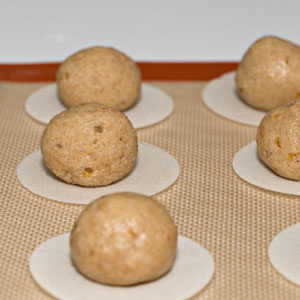
-
-
-
8.1
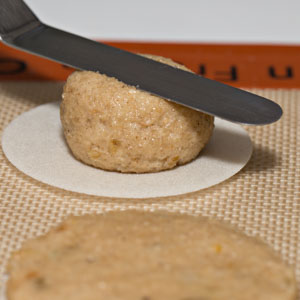
-
8.2
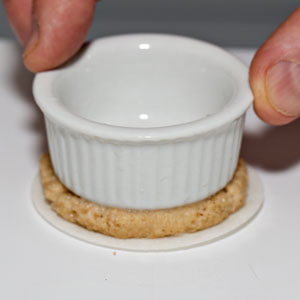
-
8.3
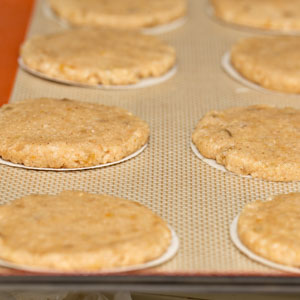
-
-
-
11.1
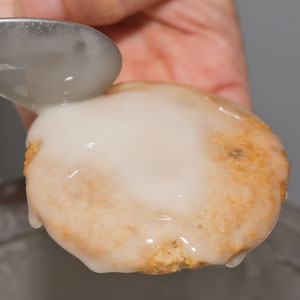
-
11.2
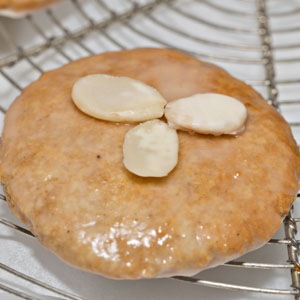
-
11.3
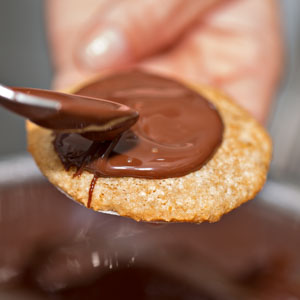
-
11.4
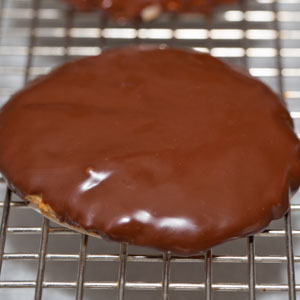
-